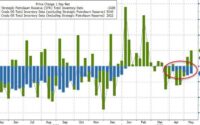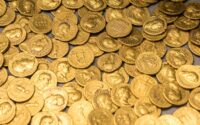Goldman Sachs 2700, Bank of America 3000, and UBS 4000!
Will the price of gold challenge analysts’ expectations once again?
Gold is the only one with the most impressive recent market performance. Currently, no one seems to be able to stop the rapid rise in gold prices.
Although rising geo-risk in the Middle East is driving safe-haven demand, this round of rise is still at odds with many other factors.
It is impossible to explain it according to the Federal Reserve’s policy logic, and the central bank is unable to rationalize the record high of gold prices. At the same time, the sharp rise in gold prices is also contrary to the outflow of gold ETFs. The “mysterious force” driving the rebound has left analysts very puzzled.
However, if you don’t understand it, you can’t understand it. The big Wall Street banks still raised their target price for gold one by one after another: Goldman Sachs is bullish to 2,700 US dollars, the Bank of America is expecting 3,000 US dollars, and UBS is calling out a high level of 4,000 US dollars, double the current price.
Goldman Sachs is bullish to $2,700
Goldman Sachs believes that the power of “fear” will raise the price of gold to 2,700 US dollars/ounce by the end of this year. Goldman Sachs stated in the report:
Traditional macroeconomic factors can no longer fully explain the speed and magnitude of the rise in gold prices. Although the market expects the Fed to cut interest rates less, economic growth will be strong, and the stock market will set a record, the price of gold has risen 20% in the past two months.
In fact, since mid-2022, most of the rise in gold prices has been driven by new incremental factors, “fear,” including “fear” that the monetary system will be difficult to maintain, fear of currency depreciation by emerging market central banks, and “fear” about US fiscal sustainability and the general election.
“Fear” that the monetary system is difficult to maintain: This fear is structural, and the market’s confidence in an international monetary system supported by the US dollar is being challenged. For example, gold has risen along with real interest rates in the recent period, indicating a clear shift in risk appetite to real assets, and market confidence in the financial system is being challenged.
Emerging market central banks’ fear of currency depreciation: Emerging market central banks are fueling the accumulation of gold by concerns about geopolitics and currency depreciation, and the preference for direct gold holding is further exacerbating this concern.
Furthermore, concerns about US fiscal sustainability, combined with end-of-line risks brought about by the election cycle, can be seen as another characteristic of fostering structural fears, which have a positive impact on gold purchases.
Although interest rate cuts are yet to arrive, gold will continue to perform well, driven by central bank demand, US fiscal conditions, and geopolitical conditions.
Bank of America is expected to be $3,000, and it is also optimistic about silver’s performance
Bank of America commodity strategist Michael Widmer gave a target price of 3,000 US dollars/ounce, while optimistic about silver’s performance:
Gold and silver are being promoted by central banks, Chinese investors, and a growing number of Western buyers. Macroeconomic factors are favorable to gold and silver, including that the Federal Reserve will cut interest rates during the year. Once interest rate cuts are implemented, gold purchases should expand, which may further push up the price of gold.
However, the performance of some traditional supporting factors has weakened, and the positive relationship between gold prices and physically supported ETFs has broken down.
The scale of asset management for physically supported ETFs has been declining, and most outflows are driven by the liquidation of investment advisors (usually agents of retail investors). Similarly, net institutional commercial futures positions are also far below recent highs.
Silver can also benefit from this, and stronger industrial demand will also boost the price of silver, which may rise above $30 per ounce in the next 12 months.

UBS called out a high of $4,000
UBS predicts that the price of gold may nearly double from now to 4,000 US dollars/ounce, and believes that it is not too late to participate in this round of gold rebound.
The recent surge in gold prices reminds me of a famous saying: “Nothing happened for decades, then decades of things happened within a few weeks.”
Historical data shows that the price of gold may be sluggish for a long time, but once it breaks through, the rise will often be rapid and intense.
The price of gold exploded in 2007, and it took 27 years to return to its 1980 high. Recently, the price of gold broke through a new high in March 2024, and it took 13 years to return to its 2011 high.
When the price of gold exploded, it surged sharply by 4 times in 2 years (1972-74 and 1978-80) and 2 times within 3 years (2008-11).

Investors can refer to past market prices for inspiration when deciding whether to pursue or avoid the recent rise in gold prices. Here, I define a “breakthrough” as the price of gold being 10% higher than the previous historical peak.
If history repeats itself, it’s not too late to participate in this gold rebound. Investors holding 2-3 years may see the price of gold double to more than 4,000 US dollars.
The signal for take-profit signals is a negative real interest rate turn negative and an overall recession. Since real interest rates are still high and the recession seems far away, it is still too early to announce the end of the rise in gold prices.
Editor/Somer
[ad_2]
Source link


